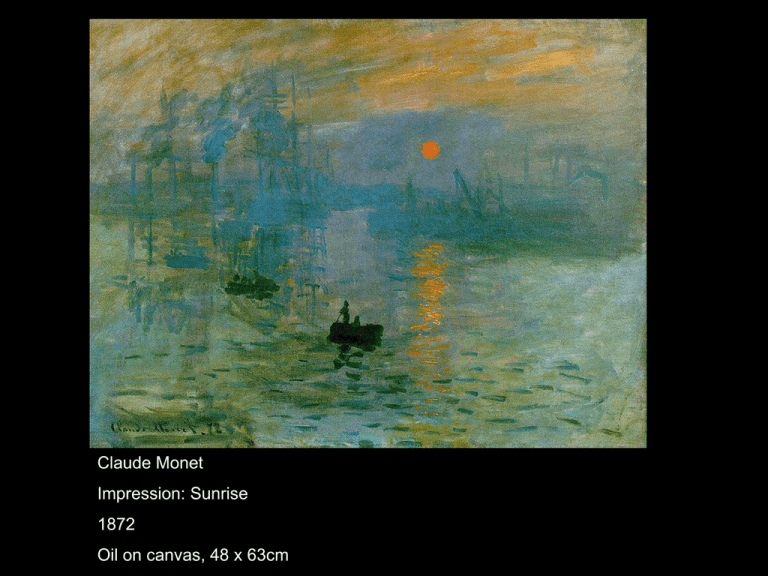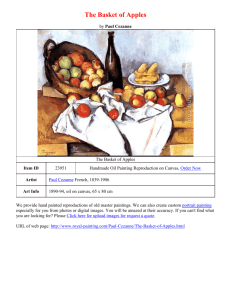post-impressionism
advertisement

Claude Monet Impression: Sunrise 1872 Oil on canvas, 48 x 63cm Works by the Impressionists Post-Impressionism Post-Impressionism • Term coined by the British artist and art critic Roger Fry in 1910 to describe the development of French art after Impressionism • The term was used when Fry organized the 1910 exhibition -- Manet and PostImpressionism Post-Impressionism • Created works during the 1880s in Paris, France • 4 Key Post-Impressionists: – – – – Paul Cezanne Paul Gauguin Vincent Van Gogh Georges Seurat The Post-Impressionists • Started off painting in the Impressionist style but later developed their own highly personal style. • The Post-Impressionists rejected the Impressionists aim of capturing fleeting moments in favour of more ambitious expression. IMPRESSIONISM - Depict momentary sensation of light & colour - Use of a bright palette. POST-IMPRESSIONISM Move beyond the visual/perceptual experience. - Van Gogh & Gauguin ~ Emphasis on feelings/emotions - Cezanne & Seurat ~ Emphasis on form (3D volume) & structure Father of Modern Art PAUL CEZANNE 1839 - 1906 POST-IMPRESSIONISM Pablo Picasso Still Life with a Bottle of Rum 1911 The experiments by Cezanne paved the foundation for the works of Picasso. PAUL CEZANNE Mt St Victoire 1895 Oil on canvas PAUL CEZANNE 1839 - 1906 Mt St. Victoire with the Great Pine 1885 - 87 POST-IMPRESSIONISM PAUL CEZANNE 1839 - 1906 - Captured the timeless beauty of Mont St. Victoire - Best remembered for his still-lifes and landscape paintings. POST-IMPRESSIONISM PAUL CEZANNE 1839 - 1906 • Beginnings / Early works: - Thickly painted ~ Paint was laid on with unskillful vigour with a palette knife ~ Crude appearance with heavy impasto & dark colour - Dominant use of dark colours ~ Black, white, tans, greys, occasion touches of brilliant colour ~ Strong contrasts of black & white. POST-IMPRESSIONISM PAUL CEZANNE 1839 - 1906 Portrait of the Artist’s Father 1866 Early Works PAUL CEZANNE 1839 - 1906 The Black Clock 1869 - 71 Early Works PAUL CEZANNE 1839 - 1906 • 1870 - 71: - Preoccupied with landscape painting Landscape 1870 -71 Early Works PAUL CEZANNE 1839 - 1906 • 1872 -- First encounters with Impressionism: - Under the influence of Camille Pissarro: ~ Started painting outdoors ~ Stopped using palette knife Camille Pissarro The Orchard 1872 ~ Juxtaposed bright colours & avoided black ~ Created a complex mosaic of delicately balanced touches of colour POST-IMPRESSIONISM PAUL CEZANNE 1839 - 1906 Landscape at Auvers 1873 POST-IMPRESSIONISM PAUL CEZANNE 1839 - 1906 House of the Hanged Man 1873 - Blocks of form solidly defined and kept in balance by arrangement of horizontals, verticals & diagonals POST-IMPRESSIONISM PAUL CEZANNE 1839 - 1906 • Lessons Cezanne learnt from Impressionism: - Use of brushstrokes as a constructive tool to model volume - Interplay of colours * Evolved to study the relationship between colours, tones & forms POST-IMPRESSIONISM PAUL CEZANNE 1839 - 1906 • Reactions to Impressionism: • Searched for underlying structure instead of mere depiction of light and outward surfaces • Avoided depictions of modern life; painted landscapes and still life of more classical conception • Looked for inspiration from Old Masters, such as Poussin POST-IMPRESSIONISM PAUL CEZANNE 1839 - 1906 Mt St. Victoire with the Great Pine 1885 - 87 POST-IMPRESSIONISM PAUL CEZANNE 1839 - 1906 - Mountain = An integral part of the landscape. Mt St. Victoire with the Great Pine 1885 - 87 - Landscape is framed by the trunk & branches of the pine tree - Removed any distractions of the painting POST-IMPRESSIONISM PAUL CEZANNE 1839 - 1906 - Modelled volumes & thrust them out into space as though he was chiselling them from rock. Mt St Victoire * Retained the volume of objects & the firmly constructed space which he admired in the art of the past. 1885 - 87 POST-IMPRESSIONISM PAUL CEZANNE 1839 - 1906 Mt St Victoire Seen from Bibemus 1898 - 1900 POST-IMPRESSIONISM PAUL CEZANNE 1839 - 1906 Mt St Victoire 1900 POST-IMPRESSIONISM PAUL CEZANNE 1839 - 1906 Mont St Victoire 1902 -6 POST-IMPRESSIONISM PAUL CEZANNE 1839 - 1906 Mt St Victoire, Seen from Les Lauves 1904 - 06 POST-IMPRESSIONISM PAUL CEZANNE 1839 - 1906 • Mt St. Victoire: - Built up pictorial structure by the schematic overlay of colours applied in short, square strokes of the brush - Worked at creating a permanence in the sense of timelessness that also embraces solidity & flux, order & flexibility - Aimed to take the contemporary aspects out of his subject and make them appear permanent and eternal POST-IMPRESSIONISM PAUL CEZANNE 1839 - 1906 • Development of Cezanne’s brushwork: Characteristic Style: Method of fine, long parallel strokes, applied in layer upon layer of transparent colour - Developed his characteristic colour patches through range of colour and direction of brushwork - Represented the rich diversity of planes and movements in space without losing any brilliance of colour & its reflection POST-IMPRESSIONISM PAUL CEZANNE 1839 - 1906 Self-Portrait with Rose Background POST-IMPRESSIONISM PAUL CEZANNE 1839 - 1906 Madam Cezanne in Red Armchair 1877 POST-IMPRESSIONISM PAUL CEZANNE 1839 - 1906 Boy in a Red Waist Coat 1890 - 95 POST-IMPRESSIONISM PAUL CEZANNE 1839 - 1906 •1880s - 1890s: Portraits & Figures - Impersonal / detachment from the sitter “To make a universal kind of painting, painting in which form itself is the real subject.” - Worked & reworked, structured & restructured his pictures laboriously. ~ Right balance of form and colour - Lacked life-like spontaneity but make up for this lack in their exquisite sense of order and harmony. POST-IMPRESSIONISM PAUL CEZANNE 1839 - 1906 Still-life with Fruit Basket 1890 POST-IMPRESSIONISM PAUL CEZANNE 1839 - 1906 Still-life with Apples & Oranges 1890 -1900 POST-IMPRESSIONISM PAUL CEZANNE 1839 - 1906 Basket of Apples 1890 - 1894 POST-IMPRESSIONISM PAUL CEZANNE 1839 - 1906 • Still-Lifes: - Ideal subject for working slowly - Fruits = Products of nature; Jars = Sense of craftsmanship - Focus on shapes of objects & interference of their presence to one another ~ Fruits lost sensual appearance ~ Instead they are arranged in order of occurrence of size & colours in specific sense of order & spatial relationships POST-IMPRESSIONISM PAUL CEZANNE 1839 - 1906 The Card Players 1890 - 95 POST-IMPRESSIONISM PAUL CEZANNE 1839 - 1906 The Card Players 1890 - 92 POST-IMPRESSIONISM PAUL CEZANNE 1839 - 1906 • Bathers: - Attempt at an idealised unity between man and nature in the tradition of Old Masters - Painted in the studio - Figures were based on studies of models / sculptures copied in the Louvre POST-IMPRESSIONISM PAUL CEZANNE 1839 - 1906 - Female bathers form triangular groups framed by inward slanting trees, which suggest a compact design The Large Bathers POST-IMPRESSIONISM PAUL CEZANNE 1839 - 1906 - Painted landscapes / still-lifes of more classical conceptions - Search for fundamental truths & inherent structure in nature ~ Led to unprecedented degree of abstraction - Tight & complex compositions POST-IMPRESSIONISM PAUL CEZANNE 1839 - 1906 Purpose of colour: -For structural purposes - e.g. ~ perspective, light / shade, depth / distance, shape / solidity POST-IMPRESSIONISM PAUL CEZANNE 1839 - 1906 • Way of working: -Intense observation over a long period of time - Explored properties of lines, planes, colours & their interrelationships ~ e.g. - Effect of linear direction; capacity of planes to create sensation of depth; intrinsic qualities of colour; power of colour to modify the direction and depth of lines & planes POST-IMPRESSIONISM PAUL CEZANNE 1839 - 1906 * Cezanne = The great structuralist among the Post-Impressionists. “Treat nature by the cylinder, the sphere, and the cone.” - Such comments about ‘structuring’ nature would give direction to the originators of Cubism in the 20th century. POST-IMPRESSIONISM





